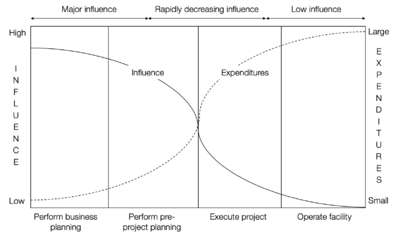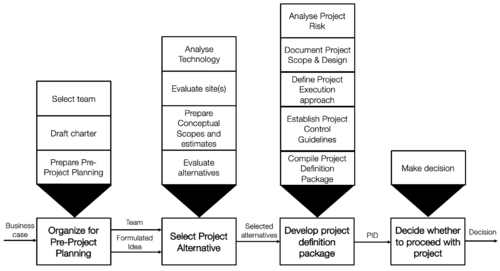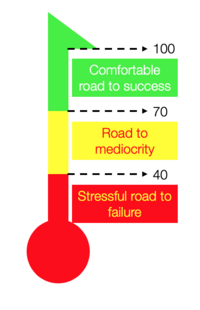Project Initiation Management in construction
| Line 54: | Line 54: | ||
**''Analyse Technology:'' This step involves evaluating the current and emerging technologies compatibility with the corporate business and operations needs. Furthermore, Scale-up problems and the technology's application should also be addressed. This element in the project initiation mangagement can have a big impact on the final outcome, and therefore careful consideration is needed when making the choice of technology. | **''Analyse Technology:'' This step involves evaluating the current and emerging technologies compatibility with the corporate business and operations needs. Furthermore, Scale-up problems and the technology's application should also be addressed. This element in the project initiation mangagement can have a big impact on the final outcome, and therefore careful consideration is needed when making the choice of technology. | ||
**''Evaluate sites:'' Different sites are evaluated that meets the clients needs. This can be based on different criteria such as access to raw materials, labor costs, utilities or market area. Additional constraints such as legal, regulatory and social issues are also needed to be taken into account. | **''Evaluate sites:'' Different sites are evaluated that meets the clients needs. This can be based on different criteria such as access to raw materials, labor costs, utilities or market area. Additional constraints such as legal, regulatory and social issues are also needed to be taken into account. | ||
| − | **''Prepare Conceptual Scopes and Estimates:'' | + | **''Prepare Conceptual Scopes and Estimates:'' The information from the different alternatives are gathered and shown in a format that permits a valid comparison based on the project objectives. This includes milestone schedules and resource requirements for each of the alternatives. |
| − | **''Evaluate Alternatives'' | + | **''Evaluate Alternatives:'' The decision maker in collaboration with the team makes the final decision on which project to choose, that is the most advantageous for the organisation. This has to be done using systematic analysis of the sites and the available technology. This can be done using a decision matrix. |
*'''Develop a Project Definition Package''' | *'''Develop a Project Definition Package''' | ||
Revision as of 15:13, 20 February 2019
Contents |
Abstract
This article will give an introduction to Project Initiation Management or Front-End management mainly in the construction industry. This includes a general introduction of how project initiation management is defined in literature and the purpose of doing good project initiation management will be presented. Project Initiation Management is all about starting projects in the right manner, defining the project phase and objectives and lastly authorising the project manager to proceed with the project [1]. This consist of making sure that stakeholders expectation's are managed and aligned with the project purpose [2], but also taking time to define the project description to a big extent. Some of the practices to ensure that a project is being initiated in the best possible way will also be presented and discussed in the subsequent sections. This encompasses Project Definition Rating Index (PDRI) as a method to initiate a project on the best possible grounds. Lastly the importance of alignment in the initiation of projects is presented to give an idea how this can make it or break in the early phases of a project, and additionally a tool to determine the alignment is presented.
Table of contents (TO BE DELETED)
- General: This section will give a general introduction to Project Initiation Mangement in construction. Furthermore this section will try to cover the current body of knowledge within this [2][3][4][5]
- Project Definition Rating Index (PDRI): The PDRI is a way to manage expectations before initiating a project and can be used as a tool in a lot of projects. This section will try to demonstrate how to apply this tool and show examples of succesful applications of this. [6]
- Reference Class Forecasting: Often projects can run over budget. Here the reference class forecasting is a way to anticipate these cost overruns by looking at past projects to see how they performed. [7]
- Alignment: For projects to be succesful the alignment from a Project Management view is essential to complete the project on time and within budget.[8]
Project Initiation Management
Project Initiation Management has many different names and definitions in litterature. This section will aim to collect the different definitions and names throughout literature, and will subsequently define the important aspect learned from these definitions. Furthermore a description of the purpose of doing good project initiation management will be presented. Lastly project initiation management used in construction projects will be assessed.
Synonyms of Project Initiation Management
- Front-end planning
- Pre-Project planning
- Project Development process
- Project Start-up
- Early Planning
- Front-end loading
- Conceptual planning
Definitions in literature and important aspects
- DS/EN ISO 21500: Guidance on project management: "The initiating processes are used to start a project, to define the project phase or project objectives and to authorize the project manager to proceed with the project work." [1]
- Axelos, Managing Successful Projects with PRINCE2: "Initiating a project is aimed at laying down the foundations in order to achieve a successful project. Specifically, all parties must be clear on what the project is intended to achieve, why it is needed, how the outcome is to be achieved and what their responsibilities are, so that there can be genuine commitment to it ... to decide whether or not the project is sufficiently aligned with corporate, programme management or customer objectives to authorize its continuation. If, instead, the organization proceeds directly from starting up a project ...then it may risk committing significant financial resources to a project without fully understanding how its objectives will be achieved." [4]
- Project Management Institute:"The Initiating Process Group consists of those processes performed to define a new project or a new phase of an existing project by obtaining authorization to start the project or phase. The purpose of the Initiating Process Group is to align the stakeholders’ expectations and the project purpose, inform stakeholders of the scope and objectives, and discuss how their participation in the project and its associated phases can help to ensure their expectations are met." [5]
- Construction Industry Institute: "... the process of developing sufficient strategic information with which owners can address risk and decide to commit resources to maximise the chance for a succesful project." [3]
- AMA handbook of project management:"The important point is that work is done (sometimes a substantial amount) on developing the project definition before and in the process of leading up to the submission of the project proposal, that is, the formal request to sanction full implementation of the project ... focuses on the project in its context, particularly on early definition of the conditions for stakeholder success. Within this framework, project, program, and even aspects of portfolio management are encompassed." [2]
From these definitions the following important aspects of project initiation management is listed below
- Define the project phase: This will cover a lot of the managerial processes from Project Management such as Risk Management, budgeting and scheduling. Furthermore a project charter is made to formally authorize the project, identify the project manager responsibilities and to document business needs such as expected deliverables and economic aspects of the project [1].

- Define project objectives: This part of the project initiation management is understood as a very important aspect for project success across the standards listed above. If the project objectives are clear and concise, this will ensure that every stakeholder knows why they are doing a project, which will increase the likelihood of success. Another important aspect of defining these objectives is that they need to be aligned with the organisational objectives.
- Stakeholders: Defining clear project objectives in collaboration with the stakeholders involved in the project, would ensure that their expectations and the project purpose aligns. Furthermore the identification of the stakeholders implied by this project should be analysed and a stakeholder register should be put together.
- Authorizing the full implementation: This step is the last step of project initiation management, and should lead to either continuation or termination of the given project. It is important for this decision to be based on a solid foundation of knowledge, which would require that the previous points are well-described, otherwise not starting the project might have been better, than continuation of an ill-defined project.
From the above points it is seen that project initiation management, involve a lot of different aspects of project, programme and portfolio management [2]. Only some of these features will be described in this article. The purpose of doing good project initiation management is as mentioned above the need to make the best possible decision based on the given information at that stage. This will eventually lead to the Project Management Office choosing the right project fit for their organisational objectives and managing this project as best as possible. From Figure 1 it can be seen that the early stages of a project has a big influence on the final outcome. The curve named Influence reflect the organisations ability to affect the project outcome. From the diagram it is seen that it much easier to influence the project outcome during the pre-project planning as the expenditure is relatively small. This accentuates the need for good project initiation management, as it will probably save a lot of money. Often the project initiation management process is cut short because of resistance from both business and technical staff as the perception is that a lot of money is spend on project that potentially will not get approved or that the extensive planning takes too much time. The learnings do indicate that this is not the case, as both probability of project failure is decreased, the is improved cost predictability and the business and operational goals are more easily achieved [3]
Project Initiation Management in construction
In this section the processes that needs to be addressed in order to achieve succesfull project initiation management is further clarified. The different processes involved in the project initiation management can be viewed in Figure 2 and will be further clarified in this section. This is based on the findings and theory from the Construction Industry Institute [3]. The model shown in Figure 2 embrace the project initiation from start to the phase where a final decision is made whether to proceed with the project.

The different processes will be outlined below. For more comprehensive detailing, review "Beginning a Project the Right way" [3] and "Pre-Project Planning Handbook" [9]
- Organize for Pre-Project Planning
- Select team: The Project Initiation Management team is selected and developed. The team should include skilled and experienced members, within both business and project management, as well as expertise within the given field.
- Draft charter: The mission and responsibilities are defined and the original concept and business case is further refined into a workable project-based concept. It is important that the charter objectives are aligned with the involved stakeholders. This charter would also include major milestones and the funding needed.
- Prepare Pre-Project Planning Plan: In this step the methods and resources needed for completing the project initiation is defined and documented. This includes budgeting, project outline and responsibilities for all members of the project initiation team.
- Select Project Alternatives
- Analyse Technology: This step involves evaluating the current and emerging technologies compatibility with the corporate business and operations needs. Furthermore, Scale-up problems and the technology's application should also be addressed. This element in the project initiation mangagement can have a big impact on the final outcome, and therefore careful consideration is needed when making the choice of technology.
- Evaluate sites: Different sites are evaluated that meets the clients needs. This can be based on different criteria such as access to raw materials, labor costs, utilities or market area. Additional constraints such as legal, regulatory and social issues are also needed to be taken into account.
- Prepare Conceptual Scopes and Estimates: The information from the different alternatives are gathered and shown in a format that permits a valid comparison based on the project objectives. This includes milestone schedules and resource requirements for each of the alternatives.
- Evaluate Alternatives: The decision maker in collaboration with the team makes the final decision on which project to choose, that is the most advantageous for the organisation. This has to be done using systematic analysis of the sites and the available technology. This can be done using a decision matrix.
- Develop a Project Definition Package
- Analyse Project Risks
- Document Project Scope and Design
- Define Project Execution approach
- Establish Project Control Guidelines
- Compile Project Definition Package
- Decide whether to proceed with project
- Make decision
Project Definition Rating Index (PDRI)
| SECTION II - BASIS OF DESIGN | |||||||||
|---|---|---|---|---|---|---|---|---|---|
| CATEGORY | Definition Level | Level | Score | Max Score | |||||
| 0 | 1 | 2 | 3 | 4 | 5 | ||||
| D. SITE INFORMATION (Maximum Score = 109) | |||||||||
| D1. Site Layout | 0 | 1 | 4 | 7 | 10 | 14 | 2 | 4 | 14 |
| D2. Site Surveys | 0 | 1 | 4 | 8 | 11 | 14 | 3 | 8 | 14 |
| D3. Civil/Geotechnical Information | 0 | 2 | 6 | 10 | 14 | 19 | 4 | 14 | 19 |
| D4. Governing Regulatory Requirements | 0 | 1 | 4 | 8 | 11 | 14 | 2 | 4 | 14 |
| D5. Environmental Assessment | 0 | 1 | 5 | 9 | 12 | 16 | 5 | 16 | 16 |
| D6. Utility Sources with Supply Conditions | 0 | 1 | 4 | 7 | 10 | 13 | 1 | 1 | 13 |
| D7. Site Life Safety Considerations | 0 | 1 | 2 | 4 | 6 | 8 | 4 | 6 | 8 |
| D8. Special Water and Waste Treatment Requirements | 0 | 1 | 3 | 6 | 8 | 11 | 3 | 6 | 11 |
| CATEGORY D TOTAL | 59 | 109 | |||||||
Reference Class Forecasting
Alignment

Alignment Thermometer

| Project Name | Level of agreement | |||||
|---|---|---|---|---|---|---|
| Alignment Issues | 1 | 2 | 3 | 4 | 5 | Score |
| 1. Stakeholders are appropriately represented on the project team. | 0 | 3 | 5 | 8 | 10 | |
| 2. Project leadership is defined, effective, and accountable. | 0 | 3 | 5 | 8 | 10 | |
| 3. The priority between cost, schedule and
required project features is clear |
0 | 3 | 5 | 8 | 10 | |
| 4. Communication within the team and with
stakeholders is open and effective. |
0 | 3 | 5 | 8 | 10 | |
| 5. Team meetings are timely and productive. | 0 | 3 | 5 | 8 | 10 | |
| 6. Our team culture fosters trust, honesty, and shared values. | 0 | 3 | 5 | 8 | 10 | |
| 7. The PPP process includes sufficient funding, schedule and
scope to meet our objectives. |
0 | 3 | 5 | 8 | 10 | |
| 8. Reward and recognition systems promote meeting
project objectives. |
0 | 3 | 5 | 8 | 10 | |
| 9. Teamwork and team building programs are effective. | 0 | 3 | 5 | 8 | 10 | |
| 10. Planning tools (e.g., checklists, simulations and
work flow diagrams) are effectively used. |
0 | 3 | 5 | 8 | 10 | |
| Total score | ||||||
https://www.nap.edu/read/10870/chapter/11
Annotated Bibliography
- Beginning A Project The Right Way
- Managing Successful Projects with PRINCE2 2017
- Guide to the Project Management Body of Knowledge (PMBOK® Guide) (6th Edition).
References
- ↑ 1.0 1.1 1.2 DS/EN ISO. 21500: Guidance on Project Management. 2nd ed. ISO; 2013.
- ↑ 2.0 2.1 2.2 2.3 Dinsmore P, Cabanis-Brewin J. The AMA handbook of project management. 4th ed. New York: AMACOM; 2014. p.35-44
- ↑ 3.0 3.1 3.2 3.3 3.4 3.5 3.6 Gibson G. Pre-project planning: Beginning A Project The Right Way. 1st ed. Austin, Texas: Construction Industry Institute; 2004.
- ↑ 4.0 4.1 AXELOS A. Managing Successful Projects with PRINCE2 2017 Edition. London: The Stationery Office Ltd; 2017. p. 195-212
- ↑ 5.0 5.1 Project Management Institute, Inc. Guide to the Project Management Body of Knowledge (PMBOK® Guide) (6th Edition). Project Management Institute, Inc. (PMI); 2017.
- ↑ 6.0 6.1 Gibson Jr. G. Project Definition Rating Index: Building Projects. 3rd ed. Austin, Texas: Construction Industry Institute; 2008.
- ↑ Flyvbjerg B. From Nobel Prize to Project Management: Getting Risks Right. Project Management Institute. 2006;37(3).
- ↑ 8.0 8.1 8.2 8.3 Griffith A, Gibson Jr. G. Alignment During Preproject Planning. Journal of Management in Engineering. 2001;17(2).
- ↑ Gibson G. Pre-Project Planning Handbook. Special Publication 39-2. Austin, Texas: Construction Industry Institute; 1995.